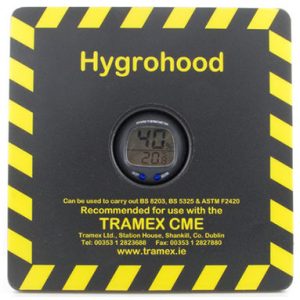How Do You Measure Humidity In Concrete? Our Expert Guide
In order to understand how you measure humidity in surfaces like concrete, you first need to know about relative humidity and its different standards.
What is relative humidity?
In simple terms, relative humidity is the amount of water vapour in the air, expressed as a percentage of the maximum amount that the air could hold at the given temperature.
What are the standards of relative humidity?
When it comes to relative humidity, the different standards that are used start to become a minefield. We’ve had a look into a few different standards and have come up with a short guide to what we think are the most used and popular standards.
ASTM F2170-09
The US standards institute (American Standards for Test & Measurement) and the F2170 relates only to in-situ method of testing. They had the hood method in another standard called F2420 but it was dropped about 2 years ago as the Americans thought the Hood test was not reliable. This standard has now been updated in 2011 so it’s now called the ASTM F2170-11 instead of the 09 version.
BS 8203
This is the British Standard for resilient floor covering and mentions only the Hood Method instead of the in-situ method.
BS 8201
This is the Wood Flooring Standard and mentions both the Hood Method and the In-situ method (the 1st British Standard to mention the in-situ method but 8203 is following soon) The problem with the British Standard mentioning the in-situ method is that it specifies a reading of 75% for both tests.
It’s impossible for both tests to read the same unless the floor is completely bone dry (which is never basically) and when the Hood method reads 75% then the in-situ is normally 80% or even 85%. British Standards should not specify a reading at all as this should by rights be left to the manufacturers of floor coverings to decide what moisture level their products can tolerate.
What are the benefits of using an RH meter?
Using an RH meter has quite a lot of advantages, which include:
- Quantitative and accurate measurements
- Long-term average of relative humidity
- The ability to measure moisture at depths of up to 40% thickness
- The best available predictor of slab behaviour.
There are some downfalls to using the meters, one being that a non-calibrated sensor can provide inaccurate results. However, this is true of any sensor, not just RH Meters.
As well as this, contamination of the reading site can lead to an inaccurate reading.
Overall, a well-calibrated RH meter can be a priceless tool for making sure your contracting project is completed without a hitch.
Our recommendation: Tramex Hygrohood
There are different machines and meters which can assess RH, the first one being the Hygrohood. The Hygrohood is a strong, robust surface humidity box tester for concrete and screeds.
The Hygrohood can be used in conjunction with the Tramex CME4 or the Tramex CMEX2 to corroborate the non-destructive moisture content test and to conform to British Standard.
There are different meters when measuring RH or moisture content, but we deal with Tramex meters as they’re a more convenient method, as well as being accurate and speedy.
Tramex meters are also easy to use and can provide various measurement results. After choosing the CM measurement option from the menu, the meter simply needs to be put against the screeded surface to get the moisture content displayed in %.
You can read more about the Hygrohood and its benefits on our website here

